The front wheel bearings needed tightening or possibly replacing, and I put if off because I didn't know how the manual front locking hub worked. I was afraid that if I undid some bolts, took the cover off, it would go PING! and little springs and parts would fly everywhere.
Eventually, when the tyres were starting to wear noticeably irregularly it was time to get to the root of the problem - the front wheel bearings.
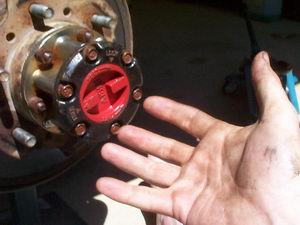
What's in there?
First you whip off the lock/free switch. Several little bolts, not stupidly tight. Once I saw what was behind it all started to make sense. Lets see if I can explain it to you huh?
Okay, the car is permanently driving the rear wheels, you select 4WD High or Low in the transfer box and then switch the manual locking hubs to "lock" to start bush-bashin'. So normally when you are in 2WD, no power is directed to the front diff. Whatsmore the hubs aren't locked so the front wheels freespin; the diff is motionless.
Once selected at the transfer box, power is directed to the front diff and out to the wheels. But without locking the hubs, that power is not connected to the wheels.
If you locked the hubs but didn't select 4WD then the wheels would actually spin the front diff.
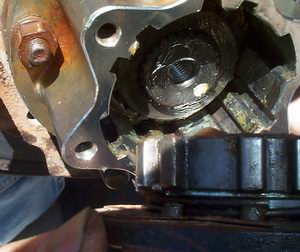
Picture 1: Ah, I see.

"Free" - withdrawn.
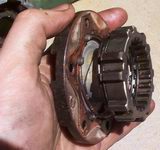
"Lock" - extended.
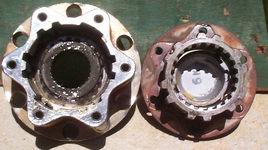
Picture 2: The olde dog'n'spline trick.
Have a look at all the photos so far. First, the hub itself is atached to the wheel. The Free/Lock switch is then attached to hub. When you switch between free and lock, a little selector thingy extends and withdraws. Now you'll notice the selector thingy has lumps (lets call them dogs) that fit into the hub - Picture 1. That means the selector thingy is also attached to the hub - but - it can extend and withdraw.
When it is extended, the inner teeth engage with the outer teeth on the driven axle - that bit you can see extending in the guts in Picture 1. So when the selector thingy is extended, the driven axle is connected to the hub. We have drive!
Notice in Picture 2 that the drive axle slips out of the spline when the hub is removed. That, well, means you can actually remove the hub ;)
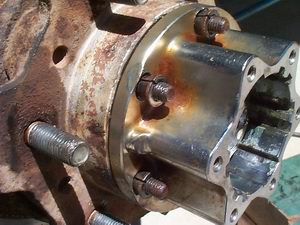
Hub off.
Whoa, how did you get the hub off? First of all you'll notice in Picture 1 that they are bolted on. In picture 2 (not immediately obvious) the bolt holes are slightly tapered.
When you undo the nuts that hold the hub on, the hub won't let go. However, some hammer blows on the hub itself right next to the nut will pop out the collets like you see in the photo.
Now don't beat it hard like the previous owner must have - just some fair whacks and rotate the thing between blows to distribute the force. Eventually all the collets will pop out and you can remove the hub.
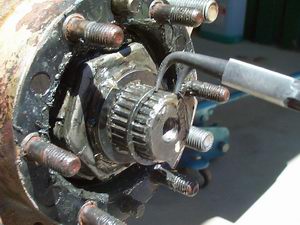
Circlip off.
Underneath is that splined driveshaft. My 4runner has CV joints which means a circlip arrangement holds the driveshaft in place so that it doesn't fall inwards. When connected to the driveshaft it sits pressed against a big shiny washer.
Pop it off, some circlip pliers are pretty essential it is a tough circlip. The washer will then slide off and you can undo the giant nut that retains the wheel bearings.
Note that the nut has a retainer thingy (yes, another thingy) that prevents it from turning. You'll probably need to bend the tabs to get everything off.

Outer wheel bearings exposed.
With all that jazz out of the way, you can now see the outer wheel bearing, you can just grab it now. Nice'n'greasy.
Notice the coppery-looking part with the slots in it? Thats what the big shiny washer is rotating against. As in it is a rotational thrust arrangement. The slots allow some grease to get in there and keep the spinning parts lubricated.
To get the inner wheel bearing you'll need to pop the brake caliper off the disk. Once the caliper is free the disk rotor can come loose, the inner bearing is on the back.
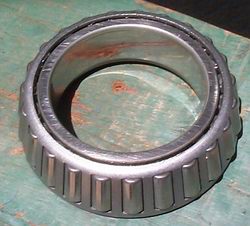
Outer wheel bearings cleaned up.
To clean and check the wheel bearing, I go for a can of degreaser and the backyard tap. Get all the grease out of it. Now the way wheel bearing works is that they are slightly angled, and the wheel bearing nut creates the holding pressure. So really, you can't tell by spinning them whether they need to be replaced or not.
My call is if they are burnt (blueish marks) or pitted then replace them. They probably ran out of grease.
As you can see, this one was fine so I just slapped heaps of wheel bearing grease back on them all and tightened them up more than they previously were. You want them tight enough so that you can't grab the wheel and rattle it; but you also want it loose enough so that you can free spin the wheel for more than say a full revolution.
JAW








 database
database